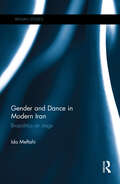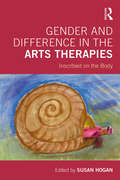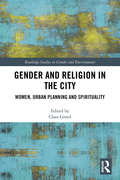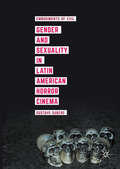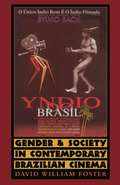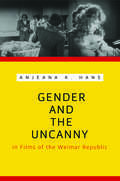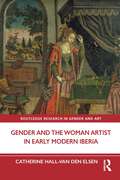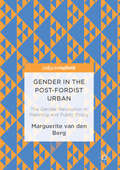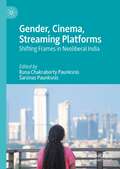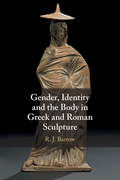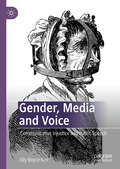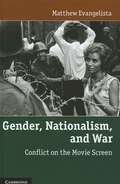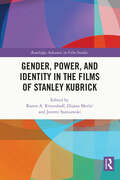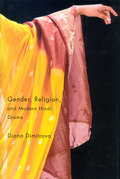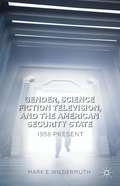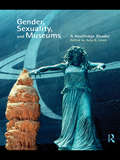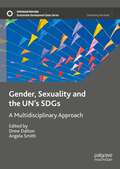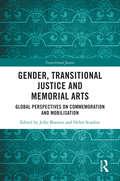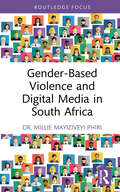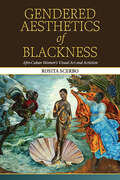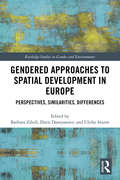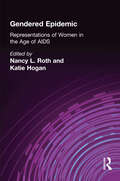- Table View
- List View
Gender and Dance in Modern Iran: Biopolitics on stage (Iranian Studies)
by Ida MeftahiGender and Dance in Modern Iran: Biopolitics on Stage investigates the ways dancing bodies have been providing evidence for competing representations of modernity, urbanism, and religiosity across the twentieth century. Focusing on the transformation of the staged dancing body, its space of performance, and spectatorial cultural ideology, this book traces the dancing body in multiple milieus of performance, including the Pahlavi era’s national artistic scene and the popular café and cabaret stages, as well as the commercial cinematic screen and the post-revolutionary Islamized theatrical stage. It links the socio-political discourses on performance with the staged public dancer, in order to interrogate the formation of dominant categories of "modern," "high," and "artistic," and the subsequent "othering" of cultural realms that were discursively peripheralized from the "national" stage. Through the study of archival and ethnographic research as well as a diverse literature pertaining to music, theater, cinema, and popular culture, it combines a close reading of primary sources such as official documents, press materials, and program notes with visual analysis of filmic materials and imageries, as well as interviews with practitioners. It offers an original and informed exploration into the ways performing bodies and their public have been associated with binary notions of vice and virtue, morality and immorality, commitment and degeneration, chastity and eroticism, and veiled-ness and nakedness. Engaging with a range of methodological and historiographical methods, including postcolonial, performance, and feminist studies, this book is a valuable resource for students and scholars of Middle East history and Iranian studies, as well as gender studies and dance and performance studies.
Gender and Difference in the Arts Therapies: Inscribed on the Body
by Susan HoganGender and Difference in the Arts Therapies: Inscribed on the Body offers worldwide perspectives on gender in arts therapies practice and provides understandings of gender and arts therapies in a variety of global contexts. Bringing together leading researchers and lesser-known voices, it contains an eclectic mix of viewpoints, and includes detailed case studies of arts therapies practice in an array of social settings and with different populations. In addition to themes of gender identification, body politics and gender fluidity, this title discusses gender and arts therapies across the life-course, encompassing in its scope, art, music, dance and dramatic play therapy. Gender and Difference in the Arts Therapies demonstrates clinical applications of the arts therapies in relation to gender, along with ideas about best practice. It will be of great interest to academics and practitioners in the field of arts therapies globally.
Gender and Power in Medieval Exegesis
by Theresa TinkleAfter establishing a feminist-historicist perspective on the tradition of biblical commentary, Tinkle develops in-depth case studies that situate scholars reading the bible in three distinct historical moments, and in so doing she exposes the cultural pressures that medieval scholars felt as they interpreted the bible.
Gender and Religion in the City: Women, Urban Planning and Spirituality (Routledge Studies in Gender and Environments)
by Clara GreedThis book provides a conceptual, historical and contemporary context to the relationships between gender, religion and cities. It draws together these three components to provide an innovative view of how religion and gender interact and affect urban form and city planning. While there have been many books that deal with religion and cities; gender and cities; and gender and religion, this book is unique in bringing these three subjects together. This trio of inter-relationships is first explored within Western Christianity: in Roman Catholicism, Protestantism, Eastern Orthodoxy and in the Pentecostal and Charismatic movements. A wider perspective is then provided in chapters on the ways in which Islam shapes urban development and influences the position of Muslim women in urban space. While official religions have declined in the West there is still a desire for new forms of spirituality, and this is discussed in chapters on municipal spirituality and on the rise of paganism and the links to both environmentalism and feminism. Finally, ways of taking into account both gender and religion within the statutory urban planning system are presented. This book will be of great interest to those researching environment and gender, urban planning and sustainability, human geography and religion.
Gender and Sexuality in Latin American Horror Cinema
by Gustavo SuberoGender and Sexuality in Latin American Horror Cinema explores the different mechanisms and strategies through which horrorfilms attempt to reinforce or contest gender relations and issues of sexualidentity in the continent. The book explores issues of machismo, marianismo,homosociality, bromance, among others through the lens of horror narrativesand, especially, it offers an analysis of monstrosity and the figure of themonster as an outlet to play out socio-sexual anxieties in different societiesor gender groups. The author looks at a wide rage of films from countries suchas Cuba, Peru, Mexico and Argentina and draws points of commonality, as well ascomparing essential differences, between the way that horror fictions -considered by many as low-brow cinema - can be effective to delve into the waythat sexuality and gender operates and circulates in the popular imaginary inthese regions.
Gender and Society in Contemporary Brazilian Cinema
by David William Foster"Gender is an absolute ground zero for most human societies," writes David William Foster, "an absolute horizon of social subjectivity." In this book, he examines gender issues in thirteen Brazilian films made (with one exception) after the 1985 return to constitutional democracy and elimination of censorship to show how these issues arise from and comment on the sociohistorical reality of contemporary Brazilian society.<P><P>Foster organizes his study around three broad themes: construction of masculinity, constructions of feminine and feminist identities, and same-sex positionings and social power. Within his discussions of individual films ranging from Jorge um brasileiro to A hora da estrela to Beijo no asfalto, he offers new ways of understanding national ideals and stereotypes, sexual dissidence (homoeroticism and transgenderism), heroic models, U.S./Brazilian relations, revolutionary struggle, and human rights violations. As the first study of Brazilian cinematic representations of gender ideology in English or Portuguese, this book will be important reading in film and cultural studies.
Gender and the Uncanny in Films of the Weimar Republic (Contemporary Approaches To Film And Media Ser.)
by Anjeana K. HansThe Weimar period in Germany was a time of radical change, when the traditions and social hierarchies of Imperial Germany crumbled, and a young, deeply conflicted republic emerged. Modernity brought changes that reached deep into the most personal aspects of life, including a loosening of gender roles that opened up new freedoms and opportunities to women. The screen vamps, garçonnes, and New Women in this movie-hungry society came to embody the new image of womanhood: sexually liberated, independent, and--at least to some--deeply threatening. In Gender and the Uncanny in Films of the Weimar Republic, author Anjeana K. Hans examines largely forgotten films of Weimar cinema through the lens of their historical moment, contemporary concerns and critiques, and modern film theory to give a nuanced understanding of their significance and their complex interplay between gender, subjectivity, and cinema. Hans focuses on so-called uncanny films, in which terror lies just under the surface and the emancipated female body becomes the embodiment of a threat repressed. In six chapters she provides a detailed analysis of each film and traces how filmmakers simultaneously celebrate and punish the transgressive women that populate them. Films discussed include The Eyes of the Mummy (Die Augen der Mumie Mâ, Ernst Lubitsch, 1918), Uncanny Tales (Unheimliche Geschichten, Richard Oswald, 1919), Warning Shadows (Schatten: Eine nächtliche Halluzination, Artur Robison, 1923), The Hands of Orlac (Orlacs Hände, Robert Wiene, 1924), A Daughter of Destiny (Alraune, Henrik Galeen,1928), and Daughter of Evil (Alraune, Richard Oswald, 1930). An introduction contextualizes Weimar cinema within its unique and volatile social setting. Hans demonstrates that Weimar Germany's conflicting emotions, hopes, and fears played out in that most modern of media, the cinema. Scholars of film and German history will appreciate the intriguing study of Gender and the Uncanny in Films of the Weimar Republic.
Gender and the Woman Artist in Early Modern Iberia (Routledge Research in Gender and Art)
by Catherine Hall-van den ElsenThis monograph explores the social constructs surrounding artistic production in early modern Iberia through the lenses of gender and class by examining the rarely considered contribution of creative women in Spain and Portugal between 1550 and 1700.Using the life-stage framework popular in texts of the period and drawing on a broad spectrum of materials including conduct guidebooks, treatises and conventual rules, this book examines the constraints imposed by gender-related social structures through microhistories of nuns, married, and unmarried women. The text spans class boundaries in its analysis of the work of painters, engravers, and sculptors, many of whom have until now eluded scholarly attention in English-language publications. An extensive bibliography promotes new avenues of inquiry into women’s contributions to the visual arts of the period.This book will be of interest to scholars working in art history, gender studies, women’s history, early modern Iberian studies, and Renaissance studies.
Gender in the Post-Fordist Urban
by Marguerite van den BergThis book investigates the gender revolution in urban planning and public policy. Building on feminist urban studies, it introduces the concept of genderfication as a means of understanding the consequences of post-Fordist gender notions for the city. It traces the changes in western urban gender relations, arguing that in the post-Fordist urban landscape gender is used for urban planning and public policy – both to rebrand a city’s image and to produce space for gender-equal ideals, often at the cost of precarious urban populations. This is a topic that remains largely unexplored in critical urban studies and radical geography. Chapters cover how Jane Jacobs’ perspectives provide an alternative to the patriarchal modernist city for contemporary planners and using Rotterdam as a case study Van Den Berg discusses why new urban planning methods focus on attracting women and children as new urbanites. Topics include: forms of place marketing, gender as a repertoire for contemporary urban Imagineering and the concept of urban re-generation. The final chapter investigates how cities aiming to redefine themselves imagine future populations and how they design social policies that explicitly and particularly target women as mothers. Scholars in all fields of urban studies will find this work thought-provoking, instructive and informative.
Gender, Cinema, Streaming Platforms: Shifting Frames in Neoliberal India
by Šarūnas Paunksnis Runa Chakraborty PaunksnisThis book offers interdisciplinary examination of gender representations in cinema and SVOD (Subscription Video on Demand) platforms in India. This book will identify how the so-called feminist enunciations in twenty-first century film and SVOD content in India are marked by an ambiguous entanglement of feminist and postfeminist rhetoric. Set against the backdrop of two significant contemporary phenomena, namely neoliberalism and the digital revolution, this book considers how neoliberalism, aided by technological advancement, re-configured the process of media consumption in contemporary India and how representation of gender is fraught with multiple contesting trajectories. The book looks at two types of media—cinema and SVOD platforms, and explores the reasons for this transformation that has been emerging in India over the past two decades. Keeping in mind the complex paradoxes that such concomitant process of the contraries can invoke, the book invites myriad responses from the authors who view the shifting gender representations in postmillennial Hindi cinema and SVOD platforms from their specific ideological standpoints. The book includes a wide array of genres, from commercial Hindi films to SVOD content and documentary films, and aims to record the transformation facilitated by economic as well as technological revolutions in contemporary India across various media formats.
Gender, Identity and the Body in Greek and Roman Sculpture
by Michael Silk Dr Rosemary BarrowGender and the Body in Greek and Roman Sculpture offers incisive analysis of selected works of ancient art through a critical use of cutting-edge theory from gender studies, body studies, art history and other related fields. The book raises important questions about ancient sculpture and the contrasting responses that the individual works can be shown to evoke. Rosemary Barrow gives close attention to both original context and modern experience, while directly addressing the question of continuity in gender and body issues from antiquity to the early modern period through a discussion of the sculpture of Bernini. Accessible and fully illustrated, her book features new translations of ancient sources and a glossary of Greek and Latin terms. It will be an invaluable resource and focus for debate for a wide range of readers interested in ancient art, gender and sexuality in antiquity, and art history and gender and body studies more broadly.
Gender, Media and Voice: Communicative Injustice and Public Speech
by Jilly Boyce KayThis book explores the increasing imperatives to speak up, to speak out, and to ‘find one’s voice’ in contemporary media culture. It considers how, for women in particular, this seems to constitute a radical break with the historical idealization of silence and demureness. However, the author argues that there is a growing and pernicious gap between the seductive promise of voice, and voice as it actually exists. While brutal instruments such as the ducking stool and scold’s bridle are no longer in use to punish women’s speech, Kay proposes that communicative injustice now operates in much more insidious ways. The wide-ranging chapters explore the mediated ‘voices’ of women such as Monica Lewinsky, Hannah Gadsby, Diane Abbott, and Yassmin Abdel-Magied, as well as the problems and possibilities of gossip, nagging, and the ‘traumatised voice’ in television talk shows. It critiques the optimistic claims about the ‘unleashing’ of women’s voices post-#MeToo and examines the ways that women’s speech continues to be trivialized and devalued. Communicative justice, the author argues, is not about empowering individuals to ‘find their voice’, but about collectively transforming the whole communicative terrain.
Gender, Nationalism, and War
by Matthew EvangelistaVirginia Woolf famously wrote 'as a woman I have no country', suggesting that women had little stake in defending countries where they are considered second-class citizens, and should instead be forces for peace. Yet women have been perpetrators as well as victims of violence in nationalist conflicts. This unique book generates insights into the role of gender in nationalist violence by examining feature films from a range of conflict zones. In The Battle of Algiers, female bombers destroy civilians while men dress in women's clothes to prevent the French army from capturing and torturing them. Prisoner of the Mountains shows a Chechen girl falling in love with her Russian captive as his mother tries to rescue him. Providing historical and political context to these and other films, Matthew Evangelista identifies the key role that economic decline plays in threatening masculine identity and provoking the misogynistic violence that often accompanies nationalist wars.
Gender, Power, and Identity in The Films of Stanley Kubrick (Routledge Advances in Film Studies)
by Jeremi Szaniawski Karen A. Ritzenhoff Dijana MetlićThis volume features a set of thought-provoking and long overdue approaches to situating Stanley Kubrick’s films in contemporary debates around gender, race, and age – with a focus on women’s representations. Offering new historical and critical perspectives on Kubrick’s cinema, the book asks how his work should be viewed bearing in mind issues of gender equality, sexual harassment, and abuse. The authors tackle issues such as Kubrick’s at times questionable relationships with his actresses and former wives, the dynamics of power, misogyny and miscegenation in his films, and auteur ‘apologism’, among others. The selection delineates these complex contours of Kubrick’s work by drawing on archival sources, engaging in close readings of specific films, and exploring Kubrick through unorthodox venture points. With an interdisciplinary scope and social justice-centered focus, this book offers new perspectives on a well-established area of study. It will appeal to scholars and upper-level students of film studies, media studies, gender studies, and visual culture, as well as to fans of the director interested in revisiting his work with a new perspective.
Gender, Religion, and Modern Hindi Drama
by Diana DimitrovaDiana Dimitrova studies the representation of gender and religion in Hindi drama from its beginnings in the second half of the nineteenth century until the 1960s - the period when urban proscenium Hindi theatre, which originated under Western influence, matured and thrived. Her focus is on how different religious and mythological models pertaining to women have been reworked in Hindi drama and whether the seven representative dramatists discussed in this book present conservative or liberating Hindu images of the feminine. She examines how the intersections of gender, religion, and ideology account for the creation of the canon of modern Hindi drama, specifically the assertion of a conservative interpretation of orthodox Hindu images of the feminine as well as the exclusion of dramatists who introduce innovative liberating images of the feminine. The overt reason for the negative attitude toward this innovative representation of gender is that it is perceived as "Western" and thus "non-Indian." By contrast, the author's analysis of Hindu mythology, religion, and theatre history reveals that the new interpretation of gender is deeply embedded in Hindu tradition and is thus both Hindu Indian and modernist Western in character.
Gender, Religion, and Modern Hindi Drama
by Diana DimitrovaDiana Dimitrova studies the representation of gender and religion in Hindi drama from its beginnings in the second half of the nineteenth century until the 1960s - the period when urban proscenium Hindi theatre, which originated under Western influence, matured and thrived. Her focus is on how different religious and mythological models pertaining to women have been reworked in Hindi drama and whether the seven representative dramatists discussed in this book present conservative or liberating Hindu images of the feminine. She examines how the intersections of gender, religion, and ideology account for the creation of the canon of modern Hindi drama, specifically the assertion of a conservative interpretation of orthodox Hindu images of the feminine as well as the exclusion of dramatists who introduce innovative liberating images of the feminine. The overt reason for the negative attitude toward this innovative representation of gender is that it is perceived as "Western" and thus "non-Indian." By contrast, the author's analysis of Hindu mythology, religion, and theatre history reveals that the new interpretation of gender is deeply embedded in Hindu tradition and is thus both Hindu Indian and modernist Western in character.
Gender, Science Fiction Television, And The American Security State
by Mark E. WildermuthAs American security became increasingly dependent on technology to shape the consciousness of its populace and to defend them, science fiction shows like The Twilight Zone, Star Trek, and The X-Files both promoted the regime's gendered logic and raised significant questions about that logic and its gendered roles.
Gender, Sexuality and Museums: A Routledge Reader
by Amy K. LevinGender, Sexuality and Museums provides the only repository of key articles, new essays and case studies for the important area of gender and sexuality in museums. It is the first reader to focus on LGBT issues and museums, and the first reader in nearly 15 years to collect articles which focus on women and museums. At last, students of museum studies, women’s studies, LGBT studies and museum professionals have a single resource. The book is organised into three thematic parts, each with its own introduction. Sections focus on women in museum work, applications of feminist and LGBT theories to museum exhibitions, exhibitions and collections pertaining to women and individuals who are LGBT. The Case studies in a fourth part provide different perspectives to key topics, such as memorials and memorializing; modernism and museums; and natural history collections. The collection concludes with a bibliographic essay evaluating scholarship to date on gender and sexuality in museums. Amy K. Levin brings together outstanding articles published in the past as well as new essays. The collection’s scope is international, with articles about US, Canadian, and European institutions. Gender, Sexuality and Museums: A Routledge Reader is an essential resource for those studying gender and sexuality in the museum.
Gender, Sexuality and the UN's SDGs: A Multidisciplinary Approach (Sustainable Development Goals Series)
by Angela Smith Drew DaltonAgainst the backdrop of Covid-19, this edited volume will utilize a gendered lens to explore the United Nation’s Sustainable Development Goals (SDGs), with a clear focus on challenging the omission of sexuality in relation to the SDGs as well as analyzing the ways in which the SDGs are also equally relevant for Western countries. While acknowledging the importance of these goals, contributors unpack the exclusion of marginalized genders and sexualities as well as how popular media and social media contribute to the wider understanding of issues of gender and sexuality and the SDGs. This volume also dispels assumptions about the irrelevance of SDGs to countries in the West, with a particular focus on the UK. Chapters examine a variety of topics including: HIV/AIDS, sex work, global migration, climate change and environmental sustainability, poverty, education, and sexual harassment. This collection will be of interest to scholars, researchers, and students across Sociology, Gender & Sexuality Studies, Education, Development Studies and Sustainability Studies.
Gender, Space, and the Gaze in Post-Haussmann Visual Culture: Beyond the Flâneur
by Temma BalducciCharles Baudelaire’s flâneur, as described in his 1863 essay "The Painter of Modern Life," remains central to understandings of gender, space, and the gaze in late nineteenth-century Paris, despite misgivings by some scholars. Baudelaire’s privileged and leisurely figure, at home on the boulevards, underlies theorizations of bourgeois masculinity and, by implication, bourgeois femininity, whereby men gaze and roam urban spaces unreservedly while women, lacking the freedom to either gaze or roam, are wedded to domesticity. In challenging this tired paradigm and offering fresh ways to consider how gender, space, and the gaze were constructed, this book attends to several neglected elements of visual and written culture: the ubiquitous male beggar as the true denizen of the boulevard, the abundant depictions of well-to-do women looking (sometimes at men), the popularity of windows and balconies as viewing perches, and the overwhelming emphasis given by both male and female artists to domestic scenes. The book’s premise that gender, space, and the gaze have been too narrowly conceived by a scholarly embrace of Baudelaire’s flâneur is supported across the cultural spectrum by period sources that include art criticism, high and low visual culture, newspapers, novels, prescriptive and travel literature, architectural practices, interior design trends, and fashion journals.
Gender, Transitional Justice and Memorial Arts: Global Perspectives on Commemoration and Mobilization
by Jelke Boesten and Helen ScanlonThis book examines the role of post-conflict memorial arts in bringing about gender justice in transitional societies. Art and post-violence memorialisation are currently widely debated. Scholars of human rights and of commemorative arts discuss the aesthetics and politics not only of sites of commemoration, but of literature, poetry, visual arts and increasingly, film and comics. Art, memory and activism are also increasingly intertwined. But within the literature around post-conflict transitional justice and critical human rights studies, there is little questioning about what memorial arts do for gender justice, how women and men are included and represented, and how this intertwines with other questions of identity and representation, such as race and ethnicity. The book brings together research from scholars around the world who are interested in the gendered dimensions of memory-making in transitional societies. Addressing a global range of cases, including genocide, authoritarianism, civil war, electoral violence and apartheid, they consider not only the gendered commemoration of past violence, but also the possibility of producing counter-narratives that unsettle and challenge established stereotypes. Aimed at those interested in the fields of transitional justice, memory studies, post-conflict peacebuilding, human rights and gender studies, this book will appeal to academics, researchers and practitioners.
Gender-Based Violence and Digital Media in South Africa (Routledge Focus on Media and Cultural Studies)
by Millie Mayiziveyi PhiriThis book presents a new paradigm for attending to gender-based violence (GBV) social media discourse among marginalised Black women in South Africa. Focusing on the intersections of television and social media, the study charts the morphing and merging of the “inside” of the soap opera and the “outside” of the real world, amid a rise in feminist social media activism. The analysis begins with coverage of gender-based violence in a long-running South African soap opera and social media discussion of these issues, in parallel with real-world events and the collective social media response. The author offers pertinent insights into audiences in sub-Saharan Africa, presenting a new feminist trajectory for women and activism in the region. Offering new insights into an important issue, this book will be of interest to scholars and students of gender, cultural studies, film studies, television studies, sociology, development studies, feminism, media, and journalism.
Gendered Aesthetics of Blackness: Afro-Cuban Women's Visual Art and Activism (SUNY series, Afro-Latinx Futures)
by Rosita ScerboExplores how Afro-Cuban women's visual art challenges dominant narratives of race, gender, and identity.Gendered Aesthetics of Blackness delves deeply into the visual artistry and activism of Afro-Cuban women in Cuba and the United States. Influential in their communities yet overlooked in the mainstream art world and academic discourse, Harmonia Rosales, María Magdalena Campos-Pons, Belkis Ayón, and Susana Pilar practice what Rosita Scerbo calls "Decolonial AfroARTivism." These women use their art to challenge and disrupt dominant narratives, reclaim their identities and cultural heritage, and advocate for social justice. In centering their voices and meticulously analyzing their works, Scerbo not only enriches our understanding of Afro-Cuban visual culture but also pushes the boundaries of research. Groundbreaking in its decolonial approach and form, Gendered Aesthetics of Blackness engages a wide swath of sources and includes two interviews, with Rosales and with curator and popular educator Diarenis Calderon Tartabull.
Gendered Approaches to Spatial Development in Europe: Perspectives, Similarities, Differences (Routledge Studies in Gender and Environments)
by Barbara Zibell Doris Damyanovic Ulrike SturmThis book explores the extent to which gendered approaches are evident and effective in spatial development in selected European countries. Beginning with an introduction to theories and concepts of gender, space and development, the book includes a brief historical review of gender in spatial planning and development throughout Europe in general, and an overview of different national frameworks in European countries, comparing legal, organisational and cultural similarities and differences. This is followed by a critical reflection on how simplifications and stereotypes of gender concepts are used in the practice of spatial development. The main part of the book offers a transnational discussion of planning practices on selected thematic topics. It starts with gender-sensitivity in urban master planning and at neighbourhood level referring to different types of planning manuals. Furthermore, the book focuses on gender-sensitive evaluation in urban planning as well as international agendas for sustainable development as a framework for a new generation of gender equality policies. The chapter authors assert that climate change, migration and austerity have threatened gender equality and therefore spatial development needs to be especially alert to gender dimensions. The editors end with an outlook and suggestions for further action and research on gender issues in spatial development. With inputs from some of Europe’s leading thinkers on gender, space and development, this volume is designed to inspire students, scholars and practitioners to reflect upon the contribution that gendered approaches can make in the various fields of spatial development and environmental planning.
Gendered Epidemic: Representations of Women in the Age of AIDS
by Nancy L. Roth Katie HoganFirst Published in 1998. Routledge is an imprint of Taylor & Francis, an informa company.
